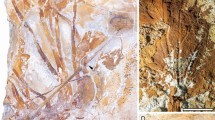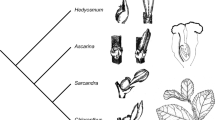Abstract
A review of methods used in the taxonomy of the Fagaceae is presented, with a critical focus made on the nomenclature of extant and fossil taxa, notablyNothofagus. The most recent classifications of the family and the problems of character weighting are considered, and an argument is made to reduce the subfamilies to tribes. The origin of the cupule is then discussed. Interpretations of the cupule as a series of reduced dichasial axes are criticized for their essentialistic approach, lack of evolutionary evidence and failure of application to the family as a whole. With the postulating of an ancestral form, the origin of the cupule involving a combination of characters from an outer tripartite perianth whorl and the pericarp is proposed. The theory provides for the evolution of the thin-walled dry pericarp and all the cupule forms found in the family today.
Similar content being viewed by others
Literature Cited
Ashton, P. S. 1977. Ecology and the Durian Theory. Gard. Bull. Straits Settlem.29: 19–23.
—. 1982. Dipterocarpaceae. Fl. Males. Bull.9(2): 237–553.
Audley-Charles, M. G. 1987. Dispersal of Gondwanaland: Relevance to evolution of the angiosperms. Pages 5–25in T. C. Whitmore (ed.), Biogeographical evolution of the Malay Archipelago. Clarendon Press, Oxford.
Baillon, H. 1876. Recherches organogéniques sur les Amentacées. Compt. Rend. Assoc. Franc. Avancem. Sci.4: 756–771.
Bertalanffy, L. von 1975. Perspective on general system theory. Scientific-philosophical studies. Braziller, New York.
Berry, E. W. 1923. Tree ancestors. Williams and Wilkins Co., Baltimore.
Bessey, C. E. 1897. Phylogeny and taxonomy of the angiosperms. Bot. Gaz. (London)24: 145–178.
Brett, D. W. 1964. The inflorescence ofFagus andCastanea and the evolution of the cupules of the Fagaceae. New Phytol.63: 96–118.
Camus, A. 1936–1954. Les Chênes: Monographique du Genre Quercus. 3 vols. Lechevalier, Paris.
de Candolle, A. 1848. Prodromus. Vol.16(2). Masson, Paris.
Carlquist, S. 1980. Anatomy and systematics of Balanopaceae. Allertonia2: 191–246.
Corner, E. J. H. 1949. The Durian Theory or the origin ofthe modern tree. Ann. Bot. (London)27: 367–414.
—. 1958. Transference of function. Bot. J. Linn. Soc.56: 33–40.
—. 1967. On thinking big. Phytomorphology17: 24–28.
-. 1976. The seeds of dicotyledons. Cambridge University Press.
—. 1990. OnTrigonobalanus (Fagaceae). Bot. J. Linn. Soc.102: 219–223.
Crane, P. R. 1984. Misplaced pessimism and misguided optimism: A reply to Mabberley. Taxon33: 79–82.
Crepet, W. L. &K. C. Nixon. 1989. Earliest megafossil evidence of Fagaceae: Phylogenetic and biogeographic implications. Amer. J. Bot.76: 842–855.
Cronquist, A. 1968. The evolution and classification of flowering plants. Nelson, London & Edinburgh.
—. 1981. An integrated system of classification of flowering plants. Columbia University Press, New York.
—. 1988. The evolution and classification of flowering plants, ed. 2. New York Botanical Garden, New York.
Eichler, A. W. 1878. Blüthendiagramme, 2. Verlag von Wilhelm Engelmann, Leipzig.
Elias, T. S. 1971. The genera of Fagaceae in the southeastern United States. J. Arnold Arbor.52: 159–195.
Fey B. S. 1981. Untersuchungen über Bau und Ontogenese der Cupula, Infloreszenzen und Blüten sowie zur Embryologie bei Vertretern der Fagaceae und ihre Bedeutung für die Systematik. Dissertation deposited at University of Zurich.
— &P. K. Endress. 1983. Development and morphological interpretation of the cupule in Fagaceae. Flora173: 451–468.
Forman, L. L. 1962. A new genus in the Fagaceae. Taxon11: 139–140.
—. 1964.Trigonobalanus, a new genus of Fagaceae, with notes on the classification of the family. Kew Bull.17: 381–396.
—. 1966a. On the evolution of cupules in the Fagaceae. Kew Bull.18: 385–419.
—. 1966b. Generic delimitation in the Castaneoideae (Fagaceae). Kew Bull.18:421–426.
Groenendael, J. M. Van 1985. Teratology and metameric plant construction. New Phytol.99: 171–178.
Hallé, F. R. A. A. Oldeman &P.B. Tomlinson. 1978. Tropical trees and forests-An architectural analysis. Springer-Verlag, Berlin-Heidelberg.
Hay, A. &D. J. Mabberley. 1992. Transference of function and the origin of the Aroids: Their significance in early angiosperm evolution. Bot. Jahrb. Syst.113: 339–428.
Hill, R. S. 1991. A revised infrageneric classification ofNothofagus (Fagaceae). Bot. J. Linn. Soc.105: 37–72.
— &J. Read. 1991.Nothofagus (Fagaceae) macrofossils from Tasmania and Antarctica and their bearing on the evolution of the genus. Bot. J. Linn. Soc.105: 73–112.
Hjelmqvist, H. 1948. Studies on the floral morphology and phylogeny of the Amentiferae. Bot. Not. Suppl.2:77–121.
Hsu, Y. C. C., J. Wang, C. Y. Wu &H. W. Li. 1981.Trigonobalanus Forman: A new recorded genus of Fagaceae in China. Acta Bot. Yunnan.3: 213–215.
Hughes N. F. 1976. Palaeobiology of angiosperm origins. Cambridge University Press.
Hutchinson J. B. 1959. The families of flowering plants. Oxford University Press.
—. 1969. The evolutionary phylogeny of flowering plants. Academic Press, London.
Janzen, D. H. &P. S. Martin. 1982. Neotropical anachronisms: The fruits the gomphotheres ate. Science215: 19–27.
Jenkins R. M. 1993. A new classification within the Fagaceae. Submitted to Novon.
Jones, J. H. 1986. Evolution of the Fagaceae: The implications of foliar features. Ann. Missouri Bot. Gard.73: 228–275.
Juniper, B. E. R. J. Robins &D. M. Joel. 1989. The carnivorous plants. Academic Press, London.
Kaplan, D. R. 1980. Heteroblastic leaf development in Acacia. Morphological and morphogenetic implications. Cellule73(2): 137–203.
Kaul, R. B. 1985. Reproductive morphology ofQuercus (Fagaceae). Amer. J. Bot.72: 1962–1967.
Leavitt, R. G. 1905. Translocation of characters in plants. Rhodora7: 13–31.
Lozano, G. J. Hernandez-Camacho &J. E. Henao. 1979. Hallazgo del generoTrigonobalanus Forman, 1962 (Fagaceae) en el neotropico 1. Caldasia12: 517–537.
Mabberley, D. J. 1984. The optimistic in pursuit of the unrecognisable. Taxon33: 77–84.
-. 1987. The plant book. Cambridge University Press.
Macdonald, A. D. 1979. Inception of the cupuleof Quercus macrocarpa andFagus grandiflora. Canad. J. Bot.57: 1777–1782.
MacFarlane, J. M. 1982. Contributions to the history ofDionaea muscipula Ellis. Contributions of the botany laboratory. Morris Laboratory1: 7–44. University of Pennsylvania.
Manchester, S. R. &P.R. Crane. 1983. Attached leaves, inflorenscences, and fruits ofFagopsis, an extinct genus of fagaceous affinity from the Oligocene Florissant flora of Colorado, U.S.A.Amer. J. Bot.70: 1147–1164.
Melville, R. 1982. The biogeography ofNothofagus andTrigonobalanus and the origin of the Fagaceae. Bot. J. Linn. Soc.85: 75–88.
Minton, E. A. &D. B. Jeffreys. 1972. Modified floral parts ofDionaea muscipula. Carniv. P1. Newslett.1: 45–47.
Moore D. M. 1978. Fagaceae. Pages 60–62in V. H. Heywood (ed.), Flowering plants of the world. Oxford University Press.
Nixon, K. C. 1982. In support of recognition of the family Nothofagaceae Kuprianova. Publ. Bot. Soc. Amer., Misc. Ser.162: 102.
Nixon, K. C. &W. L. Crepet. 1989.Trigonobalanus (Fagaceae): Taxonomic status and phylogenetic relationships. Amer. J. Bot.76(6): 828–841.
Oersted, A. S. 1867. Bidrag til egeslaegtens systematick. Naturhistorische Forening Videnskaber Meddelelser8: 11–88.
Okamoto, M. 1989. A comparative study of the ontogenetic development of the cupules inCastanea andLithocarpus (Fagaceae). Pl. Syst. Evol.168: 7–18.
—. 1991. Evolutionary trends in the inflorescences and cupules of the northern Fagaceae. Bull. Osaka Mus. Nat. Hist.45: 33–48.
Payer, J. B. 1857. Elements de botanique. Masson, Paris.
Romero, E. J. 1986. Fossil evidence regarding the evolution ofNothofagus Blume. Ann. Missouri Bot. Gard.73: 276–283.
Rutishauser, R. &R. Sattler. 1986. Architecture and development of the phyllode-stipule whorls ofAcacia longipedunculata: Controversial interpretations and continuum approach. Canad. J. Bot.64: 1987–2019.
Schumann, K. 1890. Neue Untersuchungen über den Blütenanochluss. Verlag von Wilhelm Engelmann, Leipzig.
Schwarz, O. 1936. Entwurf zu einem natürlichen System der Cupuliferen und der GattungQuercus L. Notizbl. Bot. Gart. Berlin-Dahlem13: 1–22.
Smiley, C. J. &L. M. Huggins. 1981.Pseudofagus idahoensis, Gen. et sp. nov. (Fagaceae) from the Miocene Clarkia Flora of Idaho. Amer. J. Bot.68(6): 741–761.
Soepadmo, E. 1976. Fagaceae. Fl. Males. Bull.7: 265–401.
Steenis, C. G. G. J. van 1953. PapuanNothofagus. J. Arnold Arbor.34: 301–374.
—. 1954. Additional note onNothofagus. J. Arnold Arbor.35: 266–267.
—. 1971.Nothofagus, key genus of plant geography, in time and space, living and fossil, ecology and phytogeny. Blumea19: 65–98.
-. 1983. Addenda, corrigenda et emendanda. In C. G. G. J. van Steenis (ed.), Fl. Males. Bull.9(3): 563.
Takhtajan, A. L. 1968. Classification and phytogeny, with special reference to the flowering plants. Proc. Linn. Soc. London179: 221–227.
—. 1969. Flowering plants: Origin and dispersal. Oliver and Boyd, Edinburgh.
—. 1980. Outline of the classification of flowering plants. Bot. Rev.46: 225–359.
Thorne, R. F. 1973. The “Amentiferae” or Hamamelidae as an artificial group; a summary statement. Brittonia25: 393–405.
Wolfe, J. A. 1973. Fossil forms of Amentiferae. Brittonia25: 334–355.
Zimmermann, W. 1961. Phylogenetic shifting of organs, tissues and phases in pteridophytes. Canad. J. Bot.39: 1547–1553.
Author information
Authors and Affiliations
Rights and permissions
About this article
Cite this article
Jenkins, R. The origin of the Fagaceous cupule. Bot. Rev 59, 81–111 (1993). https://doi.org/10.1007/BF02856675
Issue Date:
DOI: https://doi.org/10.1007/BF02856675




